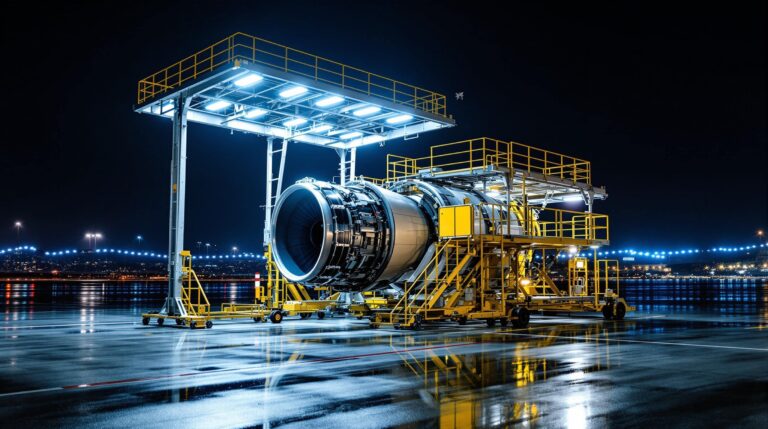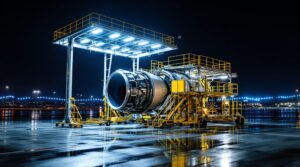ircraft engine stands have undergone significant advancements over the years, evolving from simple manual designs to sophisticated modular systems. These innovations have not only improved safety and efficiency but also transformed how maintenance, repair, and overhaul (MRO) operations are conducted in the aviation industry. This article explores the historical development of engine stands, their modern innovations, and strategies for future-proofing these essential tools.
Introduction: The Role of Engine Stands in Aviation Maintenance
Aircraft engine stands are indispensable tools in aviation maintenance. They provide a stable platform for safely transporting, storing, and servicing engines that can cost tens of millions of dollars. As aviation technology advances, so does the complexity of engine maintenance. Modern engine stands are designed to meet stringent safety standards while enhancing operational efficiency. Companies like Aero Stands have been at the forefront of this evolution, offering cutting-edge solutions tailored to the needs of MRO facilities worldwide.
For more information on advanced solutions for engine maintenance, visit stands.aero.
Historical Advancements in Aircraft Engine Stands
Early Designs: Simplicity and Limitations
In the early days of aviation, engine stands were rudimentary structures designed primarily for basic storage and transport. These manual stands often lacked adjustability and safety features, making them cumbersome to use and posing risks to both personnel and equipment.
The Shift to Adjustable Stands
As aircraft engines became larger and more complex, the need for flexible solutions grew. Adjustable stands emerged as a practical choice, allowing technicians to modify height and configuration based on the engine type or specific maintenance tasks. These designs significantly improved safety by providing better access to critical engine components.
The Modular Revolution
The introduction of modular engine stands marked a turning point in aviation maintenance. Modular systems are constructed from lightweight yet durable materials like aluminum and feature customizable components. These stands can be easily reconfigured to accommodate different engine models, making them ideal for diverse fleets.
Modern Innovations in Engine Stand Design
Enhanced Safety Features
Modern engine stands prioritize safety with features such as:
- Mechanical locking mechanisms to secure engines during transport and maintenance.
- Non-marking bumpers to protect aircraft surfaces.
- Anti-slip platforms for technician safety.
Improved Mobility
Advanced designs incorporate caster assemblies and optimized weight distribution, enabling easy movement of heavy engines within MRO facilities. Some stands even feature vibration-damping cradles to protect engines during transit.
OEM-Certified Solutions
Original Equipment Manufacturer (OEM)-certified stands ensure compliance with stringent industry standards. These certifications provide peace of mind by guaranteeing that the stand meets all requirements for safe transportation, installation, and storage.
Collaborations with Industry Leaders
Partnerships between manufacturers and aerospace giants like Lockheed Martin have driven innovation in engine stand technology. For example, collaborations often focus on integrating advanced materials and manufacturing techniques to enhance durability and performance.

Check also: https://stands.aero/product/genx-1b-2b-rollover/
Future-Proofing Investments in Engine Stands
Sustainability in Design
The aviation industry is increasingly adopting sustainable practices. Future engine stands will likely incorporate eco-friendly materials and energy-efficient manufacturing processes. Lightweight designs can reduce fuel consumption during transport, aligning with broader environmental goals.
Digital Integration
The integration of digital tools such as IoT sensors can revolutionize how engine stands are monitored and maintained. Predictive analytics could alert technicians to potential issues before they escalate, reducing downtime and repair costs.
Modularity for Long-Term Use
Investing in modular systems ensures adaptability to future aircraft models. Modular components can be upgraded or replaced individually, extending the lifespan of the stand and reducing overall costs.
FAQs: Common Questions About Aircraft Engine Stands
What are the main types of aircraft engine stands?
There are two primary types:
- Fixed-height stands: Ideal for specific tasks where adjustability is not required.
- Adjustable-height stands: Provide flexibility for servicing various engine models.
Why is OEM certification important?
OEM-certified stands comply with strict safety standards set by engine manufacturers. They ensure safe handling during transport and maintenance while minimizing risks of damage or operational delays.
How do modular stands improve efficiency?
Modular systems allow for quick reconfiguration based on specific needs. They reduce maintenance time by providing easy access to all parts of the engine.
Conclusion: A Future-Oriented Approach
The evolution of aircraft engine stands reflects the broader advancements in aviation technology. From manual designs to modular systems equipped with cutting-edge features, these tools play a critical role in ensuring the safety and efficiency of aircraft maintenance operations.
As the industry continues to grow, investing in innovative solutions like Aero Stands’ modular systems will be essential for meeting future challenges.


